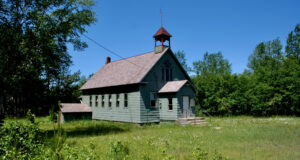The old road is one of many that can be found scattered across the peninsula – all of which share the same set of traits. With no shoulders to speak of it seems far too narrow to comfortable handle two way traffic – as if the center land marker was an afterthought. Though paved, the old asphalt’s surface is sprinkled with a spiderweb of cracks and fissures dotted with clumps of grass and weeds. Along the narrow edges the roadway has disintegrated – narrowing its available width even more. Walking across its top feels like walking atop a soggy carpet that smooshes under your feet. It’s a miracle that it supports a modern car at all – but It somehow manages.
Cars were not what the road was originally built for however. Instead its surface would have carried horses and wagons along with the occasional tractor or other piece of farm equipment. That’s because this is Salo Road, home to one of many small Finish farming communities that sprung up atop the hills along the Portage waterway. In the Finnish language the word “Salo” described a “wooded island”, more colloquially to mean “wild forest”. In the 16th century it was used to describe a small town in the country’s southern reaches, but by the 20th century had been adopted as a popular surname for many Finish families – most likely the source of the name as it exists on Copper Country maps.
Salo Road no longer carries any horses, wagons, or pieces of farm equipment however. It hardly carries anything else either, as the old community has been abandoned for some time and besides a few homes very little remains along its length. The old farms have largely disappeared from the landscape, the old fields overgrown and the landscape returning more to its original appearance. But for those observant enough to notice, there does remain one piece of old Salo to be found – that being the old school house which continues to stand stoically alongside the roadway.
